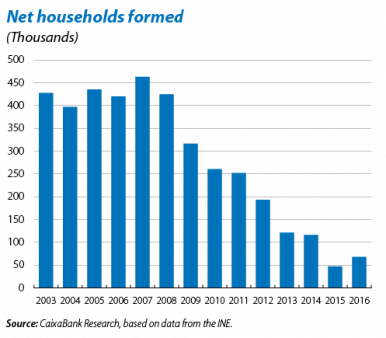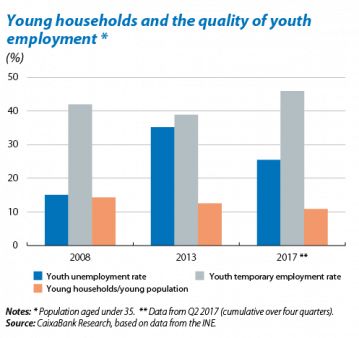Leaving home: a dream or reality for young adults?
In the past few years the number of new households being formed has started to rise. In 2016 68,200 new households were created, up by 45% on 2015. However, net household formation is still very low, especially compared with the pre-crisis years when almost 400,000 new households were created each year.1
To understand the dynamics behind household formation we need to examine how its main determining factors are changing: namely demographics and socioeconomic conditions. Since household formation is particularly concentrated among young adults, we focus our analysis on this segment.
Demographics are undeniably important. While the population under 35 years of age accounted for 42.8% of the total population in 2008, this share is now 36.5%. As there are fewer young adults, fewer households are being formed. By way of example, in the past nine years around 33,000 fewer households have been formed per year due to the demographic effect on the young adult segment of the population.2
Economic factors are also playing their part, however. Fewer young adults are leaving the parental home to set up their own household, as shown by the ratio of young households to the total young adult population falling from 14.3% in 2008 to 10.8% in 2017.
One key aspect is undoubtedly the change in the age at which young people start work. This is partly due to them studying for longer. The average age at which people under 35 finish their education has gone from 18.4 years in 2008 to 19.1 at present. But the nature of the labour market itself also seems to be a key factor. Although jobs are now being created at a good rate, youth unemployment is still high and it is difficult to reduce the temporary nature of employment, especially among the young. 46.1% of people aged under 35 who are in work are on a temporary contract (42.5% in 2008). Unemployment for this group is also at a high level of 24.3%, although this figure has fallen by over 12 pp since its peak in 2013. The average wage for workers aged between 25 and 29 also fell by 8% from 2008 to 2015 in nominal terms.
Finally, one additional factor to take into account is the growing pressure on property prices. Young adults tend to live particularly in large cities such as Barcelona and Madrid, where real estate prices are rising the most. While house prices have increased by 4.9% overall since 2015, in Barcelona and Madrid this rise has been 18.3% and 11.0%, respectively.3
1. Annual average from 2003 to 2010.
2. Assuming the share of young people forming a household out of all young people remains constant at current values.
3. Growth in the appraised value of residences available for sale, published by the Ministry of Public Works, from Q1 2015 to Q2 2017.




